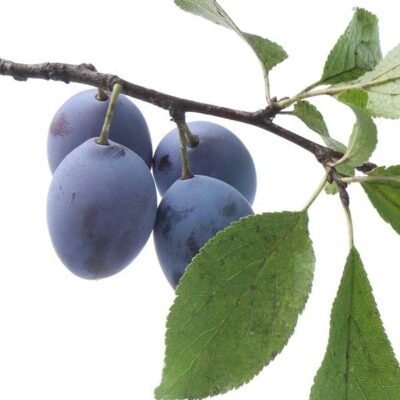Garden Plant: Brooks Plum Tree
Product Description: Brooks Plum Tree

Great-Tasting, Popular Brooks Plum Tree
- Late Mid-Season
- 800 Chill Hours
- Popular Variety
- Sweet, Large Fruit
- Purplish Black Skin Called Blue
- Yellow Flesh
- Stores Well After Harvest
- Wonderful Fresh Eating
- Super Variety for Canning and Drying
- White Blossoms in Spring
- Vigorous and Reliable Producer
- Attractive Tree
- Self-Pollinating, But Add An Italian Plum For Bigger Fruit Set
Add a healthy homemade snack with these popular European prune plums. Brooks Plum Tree (Prunus domestica \’Brooks’) can be dried, canned or enjoyed fresh.
With gorgeous dark purple skin, a profuse bloom and sweet yellow flesh, Brooks is a winning choice. And You’ll only need one tree to see fruit.
If you have the room, or want to try your hand at high-density planting, include an Italian, French Petite or French Improved Plum. You’ll be glad you did, as these marvelous trees act as pollination partners to really boost your production.
The striking, oval-shaped fruit makes a pretty sight growing along the branches. These feature a heavy bloom when ripe. No wonder people call them “Blue Plums”!
Brooks was originally found as a sport of Italian Prune Plum, and is harvested about a week before it. It is arguably one of the most popular commercial plums for drying in the United States.
Grow them at home for an unparalleled sweetness! Tree-ripe plums are so juicy and good.
European Plum that is excellent for fresh eating. You’ll get a lot of value from them, as they keep well after harvest. Dry them to prepare healthy snacks, or bake with them.
Add Brooks Plum tree to your edible landscape this season. You’ll be thrilled with the quality and versatility of these expertly grown fruiting trees.
How to Use Brooks Plum Fruit Trees in the Landscape
Use it as a wonderful specimen with pure white blossoms in early spring. The plentiful purple orbs of the ripening harvest looks amazing. Even bare fruit trees have a certain evocative charm in wintertime.
Try them in mulched beds anywhere in your landscape. No need to relegate them to the backyard. With the huge new interest in Edible Landscaping, you can place your Brooks Plum in the front yard with pride!
Add two and use them as accent trees on either side of your front walk. Just be sure to plant them at least 20 feet from your house or structure.
Allow them to grow to their full size for the maximum fruit production. Or, keep them any size with summer pruning for size control. Be sure to check out our blogs on high-density planting, and videos on size control.
You’ll adore having your own fruiting trees! And plums are some of the easiest for beginners, too.
Pro Plant Tips for Care
The biggest key to success is sunshine. Plum trees need full sun, with at least 6 hours of direct sunlight a day.
They will do best in a spot that gets plenty of good air circulation, too. Plant them away from low-lying spots that can trap air.
Give them well-drained soil that has been amended with compost. Plant in a large mound or raised bed if poor drainage is suspected.
Provide Brooks Plum moderate amounts of water on a regular basis. Mulch your tree to 3 to 4 inches deep to 3 feet outside of the canopy.
If the crop is heavy, it’s important to thin them out to increase the size of mature fruit. Spacing is about one fruit per 6 inches.
In late winter, shape your fruit tree to correct crossing branches that shade out others. Develop main scaffold limbs to carry the weight of the harvest over the course of several years.
Keep your tree smaller with summer pruning for size control. Tip prune the season’s new growth by a third. You’ll have an easier harvest, and encourage next year’s fruiting wood.
People love the sweet, healthy fruit of Brooks Plum trees.


